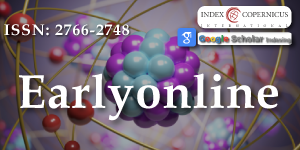Bhaskara Law and Thermal Expansion: Redefining the Principles of Energy Interaction
Main Article Content
Abstract
Thermodynamics constitutes a rigorously defined domain that elucidates the interactions of energy when they pertain to the perturbation of a singular fundamental force or characteristic. Nevertheless, it is frequently misconceived as an all-encompassing theory applicable to all energy-related phenomena. In actuality, thermodynamics is not constructed to tackle scenarios in which multiple fundamental forces or properties are concurrently perturbed. This manuscript underscores the constraints of thermodynamics in such contexts and illustrates instances such as the Curie effect and the thermal expansion of mercury, wherein multiple forces are implicated and thermodynamics in isolation proves inadequate to elucidate the fundamental mechanisms involved. The exploration of these phenomena reveals the necessity for a more integrated approach, combining thermodynamic principles with insights from other fields such as electromagnetism and fluid dynamics to achieve a comprehensive understanding. This interdisciplinary framework not only enhances the predictive power of scientific models but also paves the way for innovative applications in technology and engineering, where complex interactions between different forces are commonplace.
By embracing this holistic perspective, researchers can develop more robust solutions to real-world problems, ultimately leading to advancements in energy efficiency, material design, and the optimization of various industrial processes. Such advancements are crucial in addressing global challenges, including climate change and resource scarcity, as they enable the development of sustainable practices that minimize environmental impact while maximizing efficiency.
Article Details
Copyright (c) 2025 Babu M.

This work is licensed under a Creative Commons Attribution 4.0 International License.
The International Journal of Physics Research and Applications is committed in making it easier for people to share and build upon the work of others while maintaining consistency with the rules of copyright. In order to use the Open Access paradigm to the maximum extent in true terms as free of charge online access along with usage right, we grant usage rights through the use of specific Creative Commons license.
License: Copyright © 2017 - 2025 |  Open Access by International Journal of Physics Research and Applications is licensed under a Creative Commons Attribution 4.0 International License. Based on a work at Heighten Science Publications Inc.
Open Access by International Journal of Physics Research and Applications is licensed under a Creative Commons Attribution 4.0 International License. Based on a work at Heighten Science Publications Inc.
With this license, the authors are allowed that after publishing with the journal, they can share their research by posting a free draft copy of their article to any repository or website.
Compliance 'CC BY' license helps in:
| Permission to read and download | ✓ |
| Permission to display in a repository | ✓ |
| Permission to translate | ✓ |
| Commercial uses of manuscript | ✓ |
'CC' stands for Creative Commons license. 'BY' symbolizes that users have provided attribution to the creator that the published manuscripts can be used or shared. This license allows for redistribution, commercial and non-commercial, as long as it is passed along unchanged and in whole, with credit to the author.
Please take in notification that Creative Commons user licenses are non-revocable. We recommend authors to check if their funding body requires a specific license.
1. Wang J. An outline of modern thermodynamics. Springer; 2011:1-18. Available from: https://link.springer.com/chapter/10.1007/978-3-642-11349-9_1
2. Evans DJ, Williams SR, Searles DJ. Thermodynamics of small systems. In: Nonlinear dynamics of nanosystems. 2010;75–109. Available from: https://doi.org/10.1002/9783527629374.ch2
3. Islam MZ, Mahboob M, Lowe RL, Bechtel ES. Characterization of the thermal expansion properties of graphene using molecular dynamics simulations. J Phys D Appl Phys. 2013;46:435302. Available from: https://doi.org/10.1088/0022-3727/46/43/435302
4. Babu BM. The Bhaskara law’s interpretation of energy phenomena including the Curie effect. Int J Novel Res Dev. 2024;9(10):a604–a612. Available from: https://ijnrd.org/viewpaperforall.php?paper=IJNRD2410063
5. Ivanova KF. To the necessity of checking the validity of some premises of nonequilibrium thermodynamics. Biophysics. 2009;54:547–548. Available from: https://doi.org/10.1134/S0006350909040241
6. Siegfried RW, Solomon SC. Mercury: Internal structure and thermal evolution. Icarus. 1974;23(2):192–205. Available from: https://doi.org/10.1016/0019-1035(74)90005-0
7. Kumari M, Dass N. Volume and thermal expansion of mercury in the temperature range 0-150°C & pressure range 0-8 K bar. J Non-Cryst Solids. 1990;117–118(2):563–566. Available from: https://doi.org/10.1016/0022-3093(90)90594-C
8. Sieniutycz S. Thermodynamic limits on production or consumption of mechanical energy in practical and industrial systems. Prog Energy Combust Sci. 2003;29(3):193–246. Available from: https://doi.org/10.1016/S0360-1285(03)00020-0
9. Collins JG, White GK. Progress in low temperature physics. Thermal expansion of solids. 1964. Available from: https://doi.org/10.1016/S0079-6417(08)60157-2
10. Tamura K, Hosokawa S. Structural studies of expanded fluid mercury. J Non-Cryst Solids. 1993;156–158(2):646–649. Available from: https://doi.org/10.1016/0022-3093(93)90038-Y
11. Bhaumik ML. Deciphering the enigma of wave-particle duality. Quanta. 2016;5(1):93–100. Available from: https://doi.org/10.12743/QUANTA.V5I1.54
12. Cini M. The physical nature of wave/particle duality. In: Theoretical concepts of quantum mechanics. IntechOpen; 2012. Available from: https://doi.org/10.5772/33377
13. Boyd RN, Wakeham HRR. The effect of temperature on the structure of mercury. J Chem Phys. 1939;7:958–962. Available from: https://doi.org/10.1063/1.1750350

